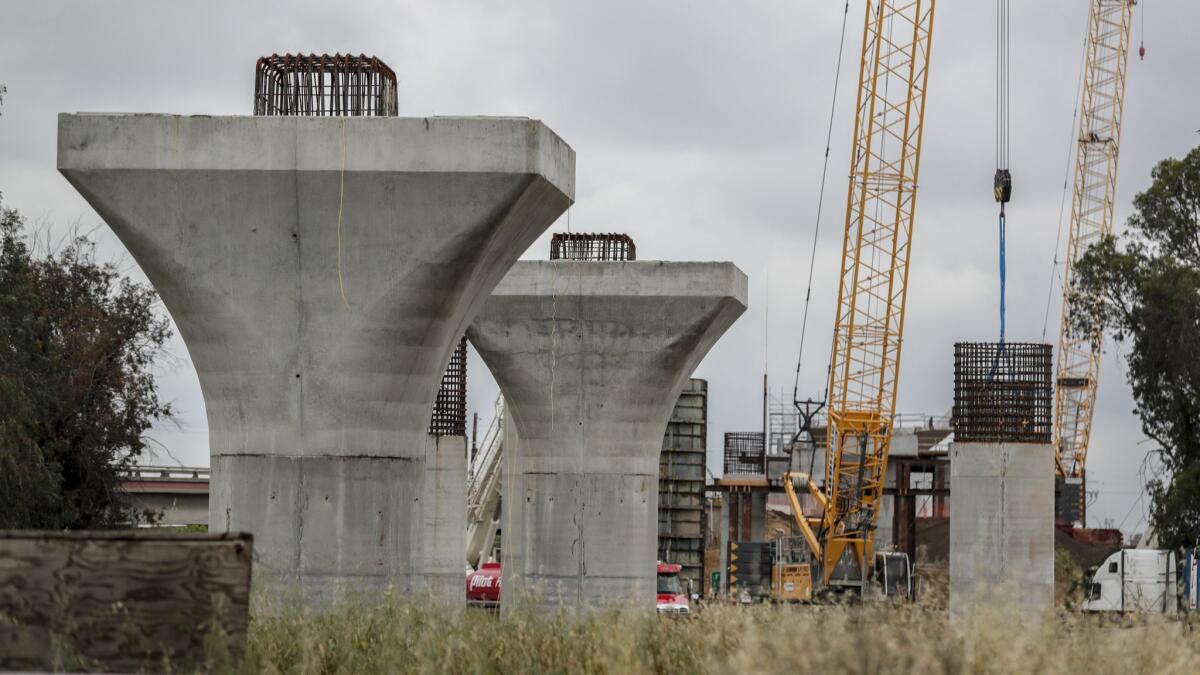On California high-speed rail project, Newsom to scale back consultants but push ahead

- Share via
The California bullet train authority, despite spiraling cost increases, schedule delays and technical snafus over the last five years, told the Legislature on Wednesday it has a solid plan to build an operating segment in the Central Valley that would economically transform the region.
The report contains some sobering caveats that legislators and state leaders will have to consider: It will cost a stunning $20.4 billion to complete just a 171-mile segment between Merced and Bakersfield, a commitment of an additional $15 billion over what has been spent to date for paper studies, environmental reports and construction.
Aiming to improve its internal operation — harshly criticized for years by auditors, analysts and reviewers — the rail authority would reduce its heavy reliance on outside consultants, said Lenny Mendonca, rail authority chairman, in a letter at the front of the report.
The rail authority asserts it has funding to complete the system, though at the low side of revenue estimates, it would end up almost broke by 2028 when the first train shoots through farm country at 220 miles per hour. On the high side of revenue estimates, it would have $3 billion left over — not enough to complete links to either Southern California or the Bay Area.
Costs for current construction over 119 miles in the Central Valley, the report says, have jumped an additional $1.8 billion, as the Times reported Tuesday, to $12.4 billion for what was originally supposed to cost about $6 billion. The partial operating system would start running in 2028, which just two years ago was the deadline for the entire Los Angeles-to-San Francisco line.
Russell Fong, the rail authority’s chief financial officer, said in an interview that the authority is taking a more conservative approach in its cost estimates, shooting for a 70% probability that its estimates are correct rather than the past level of confidence of 10%. The $1.8-billion cost increase includes money for delay claims by contractors that have not yet been resolved, settlement of legal disputes with Fresno and revised specifications on structures, among much else, Fong said.
But the report also outlines the serious risks that could fray the blueprint: new cost increases, a loss of federal grants threatened by the Federal Railroad Administration and the need for an appropriation of more than $4 billion out of bond funds from the Legislature, among much else.
Under the new plan, which was set by Gov. Gavin Newsom this year, the bullet train would connect with slower diesel-powered passenger trains in Merced. Passengers could transfer to the Altamont Corridor Express to San Jose, or to Amtrak’s San Joaquins line to Sacramento. The operation of the three lines would lose $63 million a year, raising potential legal questions of whether the state would be illegally subsidizing the bullet train.
And the plan may doom the possibility of ever building the direct bullet train link to San Jose through a costly 13-mile tunnel under the Pacheco Pass.
“Once you have built to Merced and improved the Altamont Corridor Express service, there is no reason to build Pacheco,” said Elizabeth Alexis, co-founder of a Bay Area watchdog group that has testified at congressional and legislative hearings. “The next money you will need to spend is to connect to Los Angeles.”
The 25-year run of outside consultants on the project, which was the subject of a Times report last week that showed it had resulted in flawed and mismanaged work, would be dealt with strongly, Mendonca said.
In a budget proposal this month, Newsom “will announce that critical oversight and management functions will be brought back in-house, replacing consultants with state staff. The Authority will also initiate an office-by-office review of other functions more appropriately performed by state officials — not private consultants,” Mendonca wrote in his opening letter.
Construction of a bullet train has been a political goal in California for nearly 40 years, and in recent decades each new governor has promised a plan that would make it happen. Gov. Jerry Brown said he was putting new leadership on the project that would fix past problems, a pledge now echoed by Newsom.
Assemblyman Jim Patterson (R-Fresno) said he doubts any real reform is forthcoming.
“They have turned over a multibillion-dollar project to consultants who have control over public money,” he said. “I don’t believe a word that they say.”
Patterson also rejected the claim that the 171-mile Central Valley bullet train would economically transform the region. Instead, he said, construction has left Fresno with “torn up streets, blighted property and homeless encampments.”
Fong said the rail authority has already requested approval from the Legislature to hire 10 information technology workers and put in a request for financial officers, engineers and other crucial personnel.
The rail authority has been warned repeatedly since 2010 that it was overly reliant on consulting teams. The state auditor, the legislative analyst’s office and the peer review panel for the rail project all urged the rail authority to beef up its in-house staff, saying too many key functions were under the control of consultants.
In 2008, when the rail project was shifting into high gear, the rail authority had a staff of just 10 people. By 2010, it remained under a dozen, according to former top officials. And the authority still had a relatively minuscule staff as it was preparing to issue the first major construction contracts the next year.
Twitter: @rvartabedian
More to Read
Sign up for Essential California
The most important California stories and recommendations in your inbox every morning.
You may occasionally receive promotional content from the Los Angeles Times.














